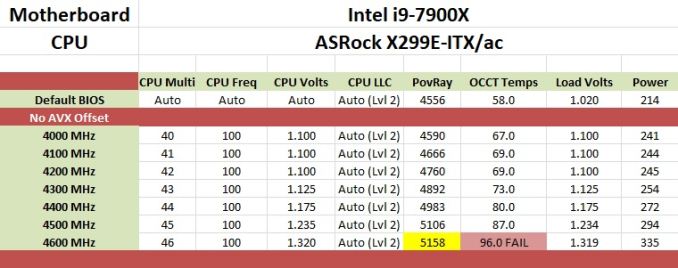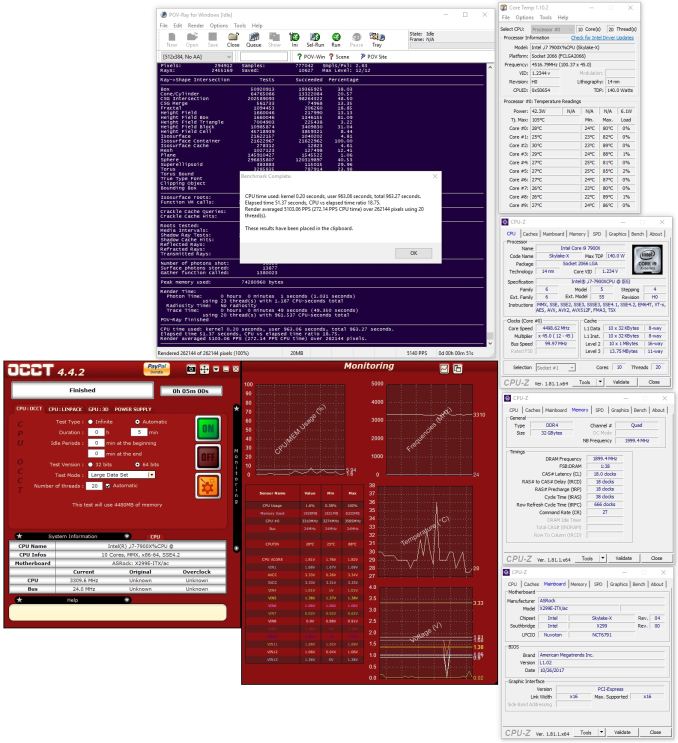The ASRock X299E-ITX/ac Motherboard Review: An 18-core No-Compromise Mini-ITX
by Joe Shields on December 4, 2017 8:00 AM ESTOverclocking
Overclocking Methodology
Our standard overclocking methodology is as follows. We select the automatic overclock options and test for stability with POV-Ray and OCCT to simulate high-end workloads. These stability tests aim to catch any immediate causes for memory or CPU errors.
For manual overclocks, based on the information gathered from previous testing, starts off at a nominal voltage and CPU multiplier, and the multiplier is increased until the stability tests are failed. The CPU voltage is increased gradually until the stability tests are passed, and the process repeated until the motherboard reduces the multiplier automatically (due to safety protocol) or the CPU temperature reaches a stupidly high level (90ºC+). Our test bed is not in a case, which should push overclocks higher with fresher (cooler) air. Room temperatures are normalized to 23C for all testing.
Experience with the ASRock X299E-ITX/ac
To start, the ASRock X299E-ITX/ac does not currently have automatic overclocking ability, outside of Multi-Core Enhancement. MCE brings all the cores to 4.5 GHz and uses more voltage than needed (1.29V compared with manual tweaking of 1.235V). The A-Tuning application does have an auto OC tune, however the option was not available with the latest release.
Manual overclocking was easy per usual, however with the ASRock BIOSes the most frequently used adjustments are in separate locations than with other BIOSes. There, most voltage options, multiplier, and BCLK were on the same page, while here there are in different sections. Not a big deal, however, it would be a bit more ergonmic if they were located on the same page. Users are able to achieve this through using the favorites page however.
The 7-phase VRM held up nicely through our testing. Though it did get hot to the touch, I did not notice throttling in our testing. The daughterboard for the SATA ports sits right over the VRM heatsink surely hindering airflow through the small heatsink. If heavy overclocking is a need on this board, I would suggest active cooling in a SFF case.
Overclocking Results
Using the X299E-ITX/ac we were able to achieve our typical limit of 4.5 GHz. This time at a slightly lesser voltage than most at 1.235V. Using the Auto function for LLC it defaults on Level 2 and yields pretty stable voltages. Voltage set at 1.235 V in the BIOS was measured as 1.234 V during load with Level 2 LLC. Power consumption of the system started off at 214W, and ended at 294W at 4.5 GHz.
The SO-DIMM DRAM used for the testing is specified at DDR4 3800 CL18-18-18-38 using the XMP profile. These are a bit different than the full-size DRAM sticks we normally use which are DDR4-2666 for one set and DDR4=3200 for the other. The OC testing was completed using these sticks set at the XMP profile. No other adjustments to the system were made.












24 Comments
View All Comments
mkaibear - Monday, December 4, 2017 - link
In before lolicabbage makes his "just buy threadripper, you never need to buy x299x comments....which would be especially funny on this article, obviously...
Hendrix2112 - Monday, December 4, 2017 - link
Am I the only one who is amazed by what the engineers who designed this did? Fitting 4 channels of ram, 3 M.2 slots, VRM to handle a *cough* 165w processor, and all the other features, is really awesome.Even though I have no interest in using this board, although I would consider it if I was going to use x299, I love seeing the limits pushed of what can currently be done with motherboard.
Good job Asrock!
Vatharian - Monday, December 4, 2017 - link
ASRock's engineers were always on the edge. They are like 'hold my beer' of an IT. Anyone remember H67 board that took Westmere CPUs, despite Intel saying 'It's NOT possible in any way?', or P4 combo, or KxN upgrade with additional S939/AM2/AM2+ expansion boards? Or general notion of having PCI-Express, and AGP on one board? Or general any arcane tomfoolery they are constantly pulling off? Every time they out something like that, I'm amazed. Need storage without dipping in Xeons? Got you covered, X99-Extreme11 with no less than 18 SATA ports. Only thing they have been beaten in so far was a board that decks out full PCIe x16 slots coverage, either ASUS with one of their WS boards or MSI with Big Bang Fusion 9 did it first, I believe.On a related note, where is review of any X399 board?
jordanclock - Monday, December 4, 2017 - link
I had an ASRock board that had both PCI-Express and AGP as well as DDR2 and DDR memory. I think it was the 4CoreDual-SATA2. It was great for someone that could only afford one upgrade at a time over a few months.mapesdhs - Thursday, December 7, 2017 - link
I've got one of those somewhere. :D Also have a board which has the AM2 upgrade option, kinda cool.vgray35@hotmail.com - Monday, December 4, 2017 - link
I wholeheartedly agree with that sentiment - a totally amazing accomplishment, and I might add for several years now I look forward to what they will come up with next. It is not long now before ASROCK implements hybrid PWM-resonant switching and resonance scaling to build VRMs with >98% efficiency (no heat sinks), where inductors are replaced by a 5mm length of copper wire. Believe it or not the X399 Threadripper will fit on a mini iTX board (expensive though).http://www.powerelectronics.com/sites/powerelectro...
Gadgety - Monday, December 4, 2017 - link
I agree, ASRock makes great boards and stretch the envelope.The_Assimilator - Monday, December 4, 2017 - link
Nope, this board is all around a very impressive piece of engineering, and massive and well-deserved kudos go to those who designed and built it. Oh, and then they added overclocking capabilities too.My only complaint is the use of SODIMMs - while that's a necessary compromise to get quad-channel on a board this tiny, it does mean that if you have existing memory you have to replace it, and any memory you do buy for this board you probably won't be able to reuse in any future builds. If I'd been designing this board, I'd probably have tried to go for 4x full-size DIMM slots on the rear of the motherboard (which would necessitate ditching the pair of M.2 slots, but oh well).
I'm still waiting for the first motherboard manufacturer that puts the power and SATA connectors on wires/ribbon cables from the rear of the board, which would open up a massive amount of real estate on the front side (not to mention help with cable routing).
edzieba - Monday, December 4, 2017 - link
Rear DIMM slots would also make it incompatible with every ITX (or ATX) case on the market: there is insufficient clearance beneath the motherboard for a DIMM, even lying that with no cosmetic 'heatsink'.The_Assimilator - Tuesday, December 5, 2017 - link
Not an issue if you right-angle the DIMM slots so that they're parallel to the motherboard instead of perpendicular - in the same way that notebooks do.